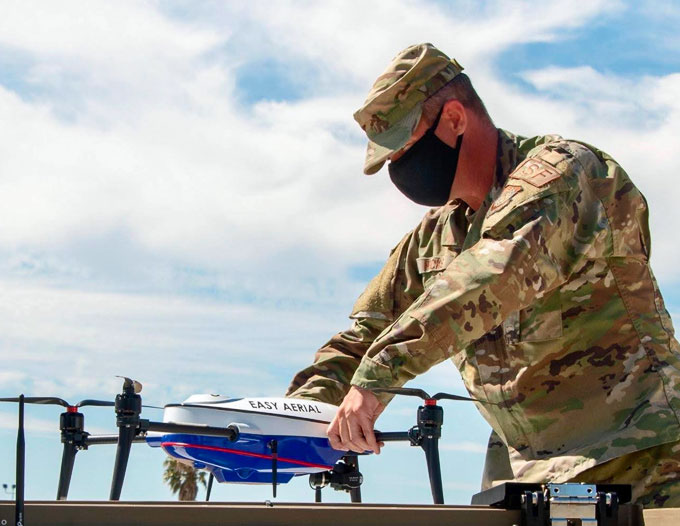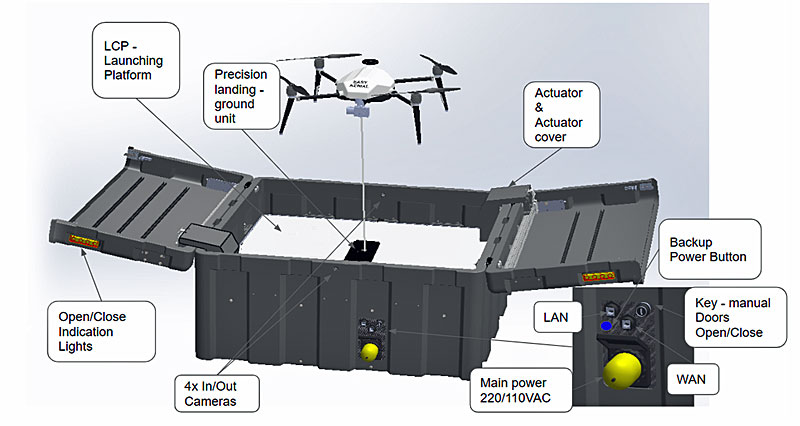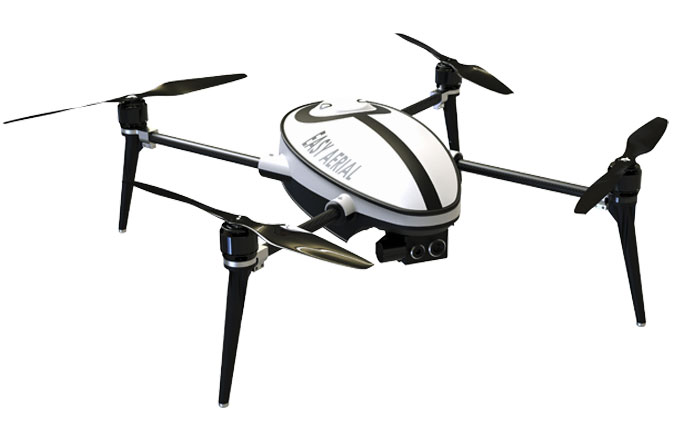
The 60th Air Mobility Wing, 60th Security Forces Squadron, in collaboration with Easy Aerial, a commercial provider of autonomous drone-based monitoring solutions, has launched the first automated drone-based perimeter security system for a United States Air Force (USAF) installation on Dec. 11th.
The small unarmed aircraft initiative redefines on-base perimeter security systems to potentially advance warfighting capabilities, enhance strategic deterrence and foster full-spectrum readiness across the Air Force.
The Smart Air Force Monitoring System (SAFMS) free-flight drone-in-a-box solution, along with a tethered version (SAFMS-T), was developed by Easy Aerial and the USAF in a span of just two years, performed under a Small Business Innovation Research (SBIR) Phase II program and conforms to the Air Force Base Perimeter Security and Situational Awareness operational requirements.
(See how Travis Air Force, Easy Aerial partner up for Autonomous Drone Based Security Operations in action. Courtesy of Travis Air Force Base and YouTube.)
SAFMS and SAFMS-T systems provide autonomous scheduled and on-demand flights that transmit the real-time HD and thermal data needed to protect both airmen and assets against airborne, ground, and potentially water-based threats in all environments.
“Easy Aerial’s unmanned aerial systems are a game-changer,” said Master Sgt. Joshua Hicks, 60th SFS small unmanned aircraft system (sUAS) instructor.
“This jointly developed technology will provide unparalleled security and safety for our Airmen and critical assets.”

“They will potentially save lives and will save time, effort, and resources as we continue to expand our training and operations across the base.”
Upon receiving a security trigger, such as a fence alarm, fire alarm or other distress call, the Smart Air Force Monitoring System can be programmed to automatically deploy from its base station and autonomously navigate to the triggered site to provide complete, unparalleled situational awareness.
Upon completing the mission, the drone autonomously returns to and lands inside the protective base station, where it will recharge and wait for the next scheduled patrol or security triggered mission.

“This was a joint effort as we worked closely together from start to finish, resulting in a customized solution for the Air Force that meets all of their operational desires and requirements,” said Ivan Stamatovski, Easy Aerial chief technology officer.
Hicks stressed the technology could save lives, time and money.
While the sight of seeing small unarmed aircraft fly around Travis Air Force Base may seem suspicious to some, Hicks said, there is no need for alarm as the drones will enhance mission effectiveness.
“The sUAS has the capability to assist civil engineering for fire response, maintenance for tail inspections … and that is just the beginning,” he added.
“The impact this program is going to have on the Air Force will be seen in many different capacities.”
The 60th Air Mobility Wing is the largest air mobility organization in the Air Force with a versatile fleet of C-5M Super Galaxy and C-17 Globemaster III cargo and KC-10 Extender refueling aircraft.
As the host unit of Travis Air Force Base, the wing controls more than $11 billion in total resources and handles more cargo and passengers than any other military air terminal in the United States, and is also the West Coast terminal for aeromedical evacuation aircraft returning sick or injured patients from the Pacific area.

When Gen. Jacqueline Van Ovost, commander of Air Mobility Command, announced her priorities for AMC in October, she stressed the importance of expanding capabilities to project the force, defend installations and networks while maintaining the joint force.
“Key to that methodology and mission success is innovation; seeing things as they can be, not how they are,” Van Ovost said.
This is truly a pioneering moment for the Air Force and the Department of Defense championed by Travis AFB, Hicks added.
SAFMS and SAFMS-T have been configured to ensure Travis AFB has options for an immediate eye in the sky that can be deployed in a matter of seconds.
SAFMS and SAFMS-T systems consist of three main components:
Easy Guard:
-
A mobile, durable, and weatherproof self-sustaining base station that fully charges the SAFMS drone in as little as 35 minutes using an internal battery.

-
Any power source, including solar, can charge the battery.
-
SAFMS-T features a smart tether-line that maintains tension and supplies constant power and two-way communication to the drone, and is capable of unlimited flight time.
-
To ensure precise, reliable, and sustained operations, the base station features GPS; the option of cellular, radio, or satellite communications; wind and temperature sensors; and internal and external cameras.
-
Each SAFMS drone can take off and land at different base stations, thus facilitating constant monitoring while recharging at multiple locations.
Falcon:

-
An autonomous high-performance drone with a modular payload system.
-
A durable and lightweight carbon fiber airframe enables it to carry various gimbaled payloads, including optical and IR cameras, floodlights, or speakers, for extended flight times of up to 45 minutes.
-
Falcon’s all-weather capability enables it to fly in fog, rain, snow, and high winds without compromising its mission.
ERMS (Easy Remote Monitoring System):

-
A secure communications and fleet operations platform enabling automated missions from a command center anywhere in the world.
-
ERMS features advanced mission planning with manual control override, flight telemetry, smart geofencing, camera controls, and real-time video feeds for persistent, 360-degree situational awareness.
“The opportunity to partner with the USAF and UAS working group at Travis AFB has been a tremendous honor and privilege,” said Ivan Stamatovski, CTO, Easy Aerial.
“I was humbled by the collective expertise, insight, and vision of this highly dedicated team without whom none of this could have been possible.”

“This was a joint effort as we worked closely together from start to finish resulting in a customized solution for the USAF that meets all of their operational desires and requirements, all while providing operational safety to the airmen and assets.
Their attention to detail and identification of the operational capabilities that needed to be modified and introduced was astounding,” added Stamatovski.
Having already realized measurable benefits from deploying SAFMS and SAFMS-T for base security at Travis AFB, multiple Air Mobility Command units and the Air Force Security Forces Center are exploring additional applications, including critical infrastructure and aircraft inspection, firefighting, asset protection, event monitoring, and surveillance.
 Developed and manufactured in the United States, Easy Aerial’s free-flight and tethered drone-in-a-box systems are fully autonomous, modular, portable, and rugged, with the ability to operate in the most adverse weather conditions.
Developed and manufactured in the United States, Easy Aerial’s free-flight and tethered drone-in-a-box systems are fully autonomous, modular, portable, and rugged, with the ability to operate in the most adverse weather conditions.
They can be deployed anywhere for a multitude of mission-critical applications such as perimeter and border security, event monitoring, first responder, agriculture monitoring, and industrial inspection, without needing a human operator.
The company’s customer base includes military, government, aerospace, and commercial organizations in North America, Europe, Africa, and Asia. Easy Aerial was founded in 2015 with headquarters in Brooklyn, New York, and regional offices in Tel-Aviv, Israel, and Belgrade, Serbia.
To Learn More, visit www.easyaerial.com.
AST strives to meet a 3 STAR trustworthiness rating, based on the following criteria:
- Provides named sources
- Reported by more than one notable outlet
- Includes supporting video, direct statements, or photos

















